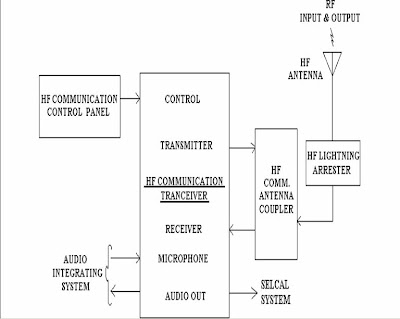The HF communication system provides long range communication between:
• The Aircraft and Ground Stations.
• The Aircraft and other Aircraft.
The system operates in the 2 to 30 MHz frequency range in Amplitude Modulated or SSB mode to transmit and receive information that can be in the form of a transmitted voice or a coded digital signal. The HF system uses the skip distance phenomena to achieve long distance transmission. Skip distance transmission is most effective in the 2 to 30 MHz ranges and varies with frequency and time of day. The HF communication provides a reliable way to transmit and receive Flight Information, Landing Instruction and Voice Communication. There are two HF communication systems HF-1 and HF-2 installed in the aircraft. Each HF communication system is composed of one receiver-transmitter, an antenna coupler, lightning arrester, an antenna, a remote control unit, a microphone, a speaker or handset and necessary relays. The HF-1&2 communication systems use 115V, 400Hz, 3-phase primary power and output from 2.0000 to 29.9999 MHz or 2.8000 to 23.9999 MHz on channels spaced at 1KHz or 100Hz.
 RECEIVER-TRANSMITTER (RT): The RT provides transmit signal and power to the antenna, and processes the received signal from the antenna. The HF RT operates in the 2.0000 to 29.9999 MHz range providing Upper Side Band and Lower Side Band data communication. The RT contains the following circuit, a frequency synthesizer, a receiver, an exciter, and a power supply. The transceiver may also contain circuit to monitor the VSWR of the antenna and transmission line. The receiver portion consists of the necessary circuit to receive, demodulate, amplify, and filter the received signal. The exciter contains the circuit to excite, modulate, amplify and transmit the voice or coded data communication.
RECEIVER-TRANSMITTER (RT): The RT provides transmit signal and power to the antenna, and processes the received signal from the antenna. The HF RT operates in the 2.0000 to 29.9999 MHz range providing Upper Side Band and Lower Side Band data communication. The RT contains the following circuit, a frequency synthesizer, a receiver, an exciter, and a power supply. The transceiver may also contain circuit to monitor the VSWR of the antenna and transmission line. The receiver portion consists of the necessary circuit to receive, demodulate, amplify, and filter the received signal. The exciter contains the circuit to excite, modulate, amplify and transmit the voice or coded data communication.

No comments:
Post a Comment